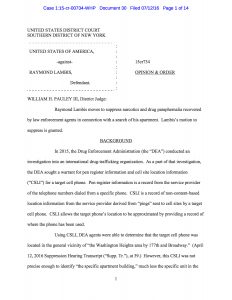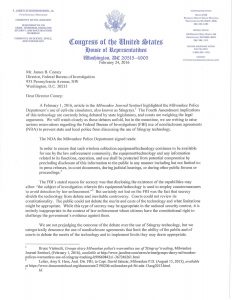 US District Judge William Pauley Suppresses “stingray” cell location evidence (Reuters): Nate Raymond writes in this Reuters article that U.S. District Judge William H. Pauley III ruled in a Southern District of New York case, that the use of a stingray to locate a cell phone constituted an unreasonable search under the IV Amendment. According to the article, a Stingray device masquerades as a cell site, thus when nearby cellular devices send “pings” the device is able to determine cell location based on the pings to and from the Stingray device.[1] Raymond’s article stated that in March a Maryland appeals court ordered evidence obtained via a Stingray be suppressed. This thus is the second such case overall, yet the first at the Federal level, according to the article. Following the Maryland court decision the Justice Department updated its internal policies to require government agents to obtain warrants prior to using cell site simulators, according to Reuters.
US District Judge William Pauley Suppresses “stingray” cell location evidence (Reuters): Nate Raymond writes in this Reuters article that U.S. District Judge William H. Pauley III ruled in a Southern District of New York case, that the use of a stingray to locate a cell phone constituted an unreasonable search under the IV Amendment. According to the article, a Stingray device masquerades as a cell site, thus when nearby cellular devices send “pings” the device is able to determine cell location based on the pings to and from the Stingray device.[1] Raymond’s article stated that in March a Maryland appeals court ordered evidence obtained via a Stingray be suppressed. This thus is the second such case overall, yet the first at the Federal level, according to the article. Following the Maryland court decision the Justice Department updated its internal policies to require government agents to obtain warrants prior to using cell site simulators, according to Reuters.
According to the actual court decision as part of the investigation, Drug Enforcement Administration (“DEA”) agents used cell site location information (“CLSI”) in order to determine a possible area in which the defendant was; however, CLSI data was not specific enough to pinpoint the actual apartment building. In an effort to obtain a tighter location grid, the DEA used a cell-site simulator to identify the apartment building and then traversed the halls of the apartment building until they were able to pinpoint the actual apartment, according to the decision. Judge Pauley cited Kyllo v. United States holding that a “fourth amendment search occurs when the government violates a subjective expectation of privacy that society recognizes as reasonable.” Judge Pauley’s decision indicated that in Kyllo, the Supreme Court held that the use of a thermal-imaging device to discern information related to the interior of the home constituted a search under the fourth amendment and required a warrant. The Kyllo Court’s premise was that when the government used a device that was not in general public use in order to explore details of the home that could not be ascertained in the absence of a physical intrusion this was a search and was therefore presumptively invalid unless preceded by a warrant, according to Judge Pauley’s decision. Judge Pauley stated that a cell-site simulator was analogous to a thermal-imaging device as 1) it was not in general public use, and 2) it revealed interior details that would be unknowable without a physical intrusion. Judge Pauley’s decision also states that cell phones are lawful devices and thus, this is distinct from using canines to sniff luggage at an airport carousel since in that case only evidence of contraband would be indicated while in the case of a cell-site simulator, any cell phone could be located whether contraband or non-contraband.
The question then becomes since both a State and now a Federal Court has ruled that evidence obtained via the use of a cell-site simulator must be suppressed, how will other circuits rule and what would the outcome be if the Supreme Court granted writ to a case involving cell-site simulators and the suppression remedy? Of course now that internal Justice Department policies allegedly advise agents to obtain warrants prior to using cell-site simulators, are we likely to see these cases going forward (it remains unclear what individual State policies are on search warrant applications for the use of cell-site simulators by state and local law enforcement agencies). As evidenced by the letter sent by Rep. Jim Sensenbrenner (R-WISC) and Rep. Sheila  Jackson (D-TX), there is some criticism concerning allegations that the FBI may be using non-dislosure agreements (“NDA”)s in order to prevent local law enforcement from disclosing any details regarding the use of or operational details related to cell-site simulators.
Jackson (D-TX), there is some criticism concerning allegations that the FBI may be using non-dislosure agreements (“NDA”)s in order to prevent local law enforcement from disclosing any details regarding the use of or operational details related to cell-site simulators.
[1] Cell-site simulators take advantage of cellular technology which relies on the ability of calls to automatically track as a user/device location changes. Thus, cellular devices transmit their International Mobile Subscriber Identity (“IMSI”) numbers as well as metadata to cell-sites (valid) or cell-site simulators (e.g. a Stingray device). The simulator is able to detect proximity and then can be used to help narrow down location information in order to discern location with greater granularity.




Leave a Reply